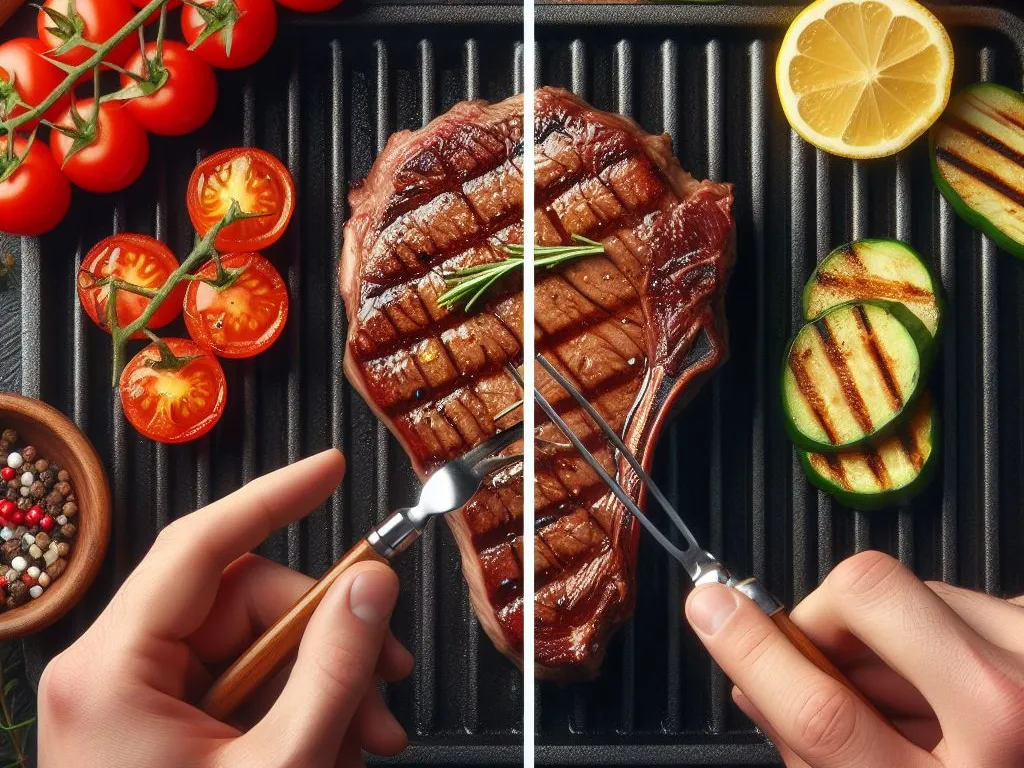How to perfect a steak’s turn, what’s the trick to learn? Check out how to flip steak for a savory, seared return!

This article is part of series. Check them out all!
There’s a common rule frequently discussed when it comes to cooking steaks – avoid meddling with the meat once it’s on the grill.
This means, once the steak hits the heat, it’s recommended to flip it only once, possibly turning it 90 degrees on each side to achieve those appealing cross-hatched grill marks.
Initially, this concept seems logical – flipping the steak just once allows for ample time for browning and charring on both sides. However, the truth is, if we repeatedly flip the steak during the cooking process, even as often as every half a minute, it can result in a crust that’s equally delightful. Not only that, it leads to a more evenly cooked interior and remarkably reduces cooking time by approximately 30%!
What is browning on meat?
The Maillard reaction (named after the French scientist who first investigated it) mirrors caramelization in its initial stages, involving relatively simple organic components subjected to heat, triggering a sequence of chemical reactions that yield numerous end products. While caramelization hinges on sugars as its precursors, Maillard browning relies on a fusion of proteins, their foundational amino acids, and sugars.
This reaction, combined with a controlled level of charring, is responsible for creating the rich, intense flavors sought after in a perfectly cooked steak, necessitating substantial heat for its formation.
Some argue that frequent flipping of a steak diminishes the extent of browning, subsequently reducing its flavor. This assertion holds some truth, but only in specific and easily preventable circumstances.
Danger of Low heat and excessive moisture
- The surface moisture on a steak must evaporate before the browning process can truly commence.
- When a steak is flipped multiple times, the side facing up undergoes a cooling effect, hindering the desired browning process. However, this setback is countered by the advantage of frequent flipping, which aids in quicker evaporation of surface moisture.
- Nevertheless, mere dryness alone may not suffice to offset the impact of a cooling surface. Consequently, when preparing relatively thin steaks with moderately moist surfaces on less-than-high-temperature skillets or grills, there’s a risk that the center might overcook before achieving adequate browning on the surfaces.
Solution of Low heat and excessive moisture
- Avoid cooking thin, damp steaks on lower-powered grills or skillets. Opting for the highest possible heat and ensuring a steak thickness of at least an inch (a minimum for any steak enthusiast), along with an effectively dried meat surface, will accelerate browning to a point where we might need to lower the heat to prevent excessive browning.
- Steaks can be dried by enveloping them in paper towels and applying firm pressure. For enhanced results, consider salting them at least 40 minutes beforehand and allowing them to rest on a rack until the salt assimilates into their surfaces. Alternatively, the most effective method involves salting them and allowing for air-drying overnight, or even longer, on a rack positioned over a rimmed baking sheet in the refrigerator.
- Alternatively, to achieve optimal results, bring the steaks to the desired temperature before commencing the searing process. This can be achieved by initiating cooking on the cooler section of a grill or utilizing a sous-vide method.
Disadvantages of Multiple Flips
Grill marks often emerge in discussions about the multiple-flip method. If we don’t meticulously manage the positioning of your steaks while flipping them, repeated flips won’t yield those impeccably crisscrossed grill marks achievable with a single flip. Yet, this doesn’t necessarily pose a drawback if we consider that grill marks overemphasized and more evenly distributed browning should be the ultimate objective.

Advantages of Multiple Flips
Accelerated Cooking
Repeatedly flipping a steak during cooking can reduce the cooking time by approximately 30% compared to flipping it just once. The rationale behind this technique is that each side of the meat gets an even exposure to heat with minimal cooling time when facing upwards. The more frequent the flips, the closer the cooking process resembles a device that simultaneously sears the meat from both sides.
Cooking on both sides means quicker preparation, translating to less waiting time before your steak is ready to be served.
Enhanced Evenness in Cooking
The genuine advantage of the multiple-flip method lies in achieving a more uniformly cooked meat from edge to edge.
Enabling each side of the steak to cool briefly after being exposed to heat allows the intense temperature contrast near the steak’s surface to diminish. This cooling period permits some of the accumulated heat energy to disperse back into the air or into the steak itself. In both scenarios, this process prevents the outer layers from cooking more than necessary.
Summary
- Browning of meat is caused by the Maillard reaction and not by caramelization.
- Flipping steak as often as 30 seconds yields more uniform cooking and better browning.
- Flipping frequently won’t produce grill marks but that takes little to none off the flavor.